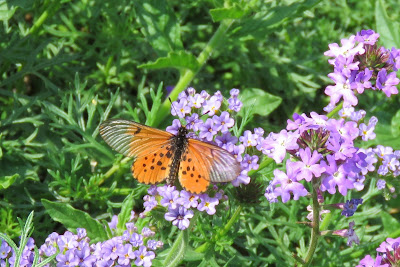A report came through about a Grey wagtail that had been located in the Walter Sisulu Botanical Gardens out on the west rand, so off I toddled. Hadn't visited since I lived on the reef in the 80's and was impressed, especially with the waterfall in spate. Eventually located the little fellow, whom I'd only met on one previous occasion but failed to get a picture - a pity as it is stunning.
However, a patch of verbena proved irresistible to a number of Garden Acrea with their see-through wings...........
.........and a flowering Pistol bush Duvernoia adhatoides sported it's unusual flowers. The name derives from the loud cracks emitted when the seed pods dehisce (or split open if you prefer).
Was also taken with the numerous benches carved from large tree trunks, altogether a rather magical place and worth a visit if you're ever in the area.
Have mentioned before that what was the Olive thrush has been recognised as two distinct species and as both occur around Jo'burg, care is needed in identification. What is now called the Karoo thrush is slightly smaller, duller and has an all yellow beak, as shown below.
Decided to go looking for some of the lesser known Boer War battle sites and Google soon produced the fact that the initial action of the first war occurred near Bronkhorstspruit - not too far down the road. The site itself is not very impressive with a couple of memorials commemorating the fact that the British took a hiding, mostly due to the pig-headedness of the commanding officer. Of more interest was the spectacular Buddhist monastery and temple, which my brother-in-law had finally persuaded me to visit. Each entrance has an grand gate guarded by Fu dogs - don't ask me I'm just the messenger...........
........and all of the structures are topped with glazed orange tiles and feature exquisitely ornate details - never ceases to amaze how much men are prepared to lavish on their beliefs.
Also in the vicinity is Majuba where the British suffered their final, catastrophic defeat at the hands of a bunch of farmers and saw them hastening to the negotiating table to bring hostilities to a close after just four months of war, in which the overall losses were overwhelmingly in favour of the Boers.
In the dim and distant past, I attended a Birdlife AGM in Newcastle and recall accompanying David Johnson on a field trip up the escarpment where we located a very unusual species of euphorbia and to this end, I took a drive up the road to Ncandu Nature Reserve but even will diligent scrutiny was unable to find it again. However the Giant candelabras Brunsvigia grandiflora were enchanting.........
.........as was this rufous-naped lark, clinging resolutely to his display perch on a rock and battling a fierce head-wind - it's all about aerodynamics you know.
Didn't manage to get close enough to identify it (though grasses are not a strong point) but large swathes of the grassland were daubed with pink.
Built in 1898 on the border between the Zuid-Afrikaansche Republiek and the Natal Colony, this bridge was, ironically, completed in 1898 shortly before the second Anglo-Boer War erupted. It spans the Buffalo River just outside Newcastle and memorial plaques at each end are in the language of the opposite side, apparently a goodwill gesture!
Years later family members and fellow soldiers erected a grave site as a pathetic reminder......
..........and a memorial to those sent to their deaths mostly through greed of others more powerful.
On a lighter note I moved from near the centre of Dundee to the Battlefields Caravan Park, 20 kms out of town and have to put up with this view for the next month.
Just down the road is the rather wonderful Talana Museum, the site of the first major clash of the second war. The Boers were ranged along this hill and the British decided to try and shift them but though they scored a tactical victory, it was somewhat pyrrhic.
The museum is so extensive that it requires several visits and features the original farmhouse of the owner of the farm, Peter Smith, the founder of Dundee. Fully restored to pristine grandeur and furnished with period pieces, it's an absolute delight.
200 m down the hill is the house his son built, now converted into a museum which details the history of the area from the San though to the 2nd World War, with all of the local battles minutely detailed.
A phenomenon I've only encountered in KZN is the "employment" of locals to cut the verges. Women, mostly, are issued with a couple of plastic cones and a small hand sickle and dropped at various sites along a length of rural road. Though I've passed dozens of them at various times of day, I've yet to come across any actually working. Look out for them if you're ever down this way, they're usually under the nearest tree, unless issued with a sun bonnet.

Newcastle, like it's English counterpart is heavily industrialized but the surrounding suburbs are pleasant, particularly one to the north up on a ridge overlooking the town.
Managed to hook up with a long lost friend who resides in Ladysmith and on the way to have lunch with him had the opportunity to visit the site of the second major punch up, Elandslaagte. On opposing ridges are memorials to the combatants, Boers one side..........
............British the other..........
............and a great gulf separating the two. Here the British secured their first clear-cut victory but squandered it by retreating from an "imaginary" superior force believed to be advancing on their position.


























